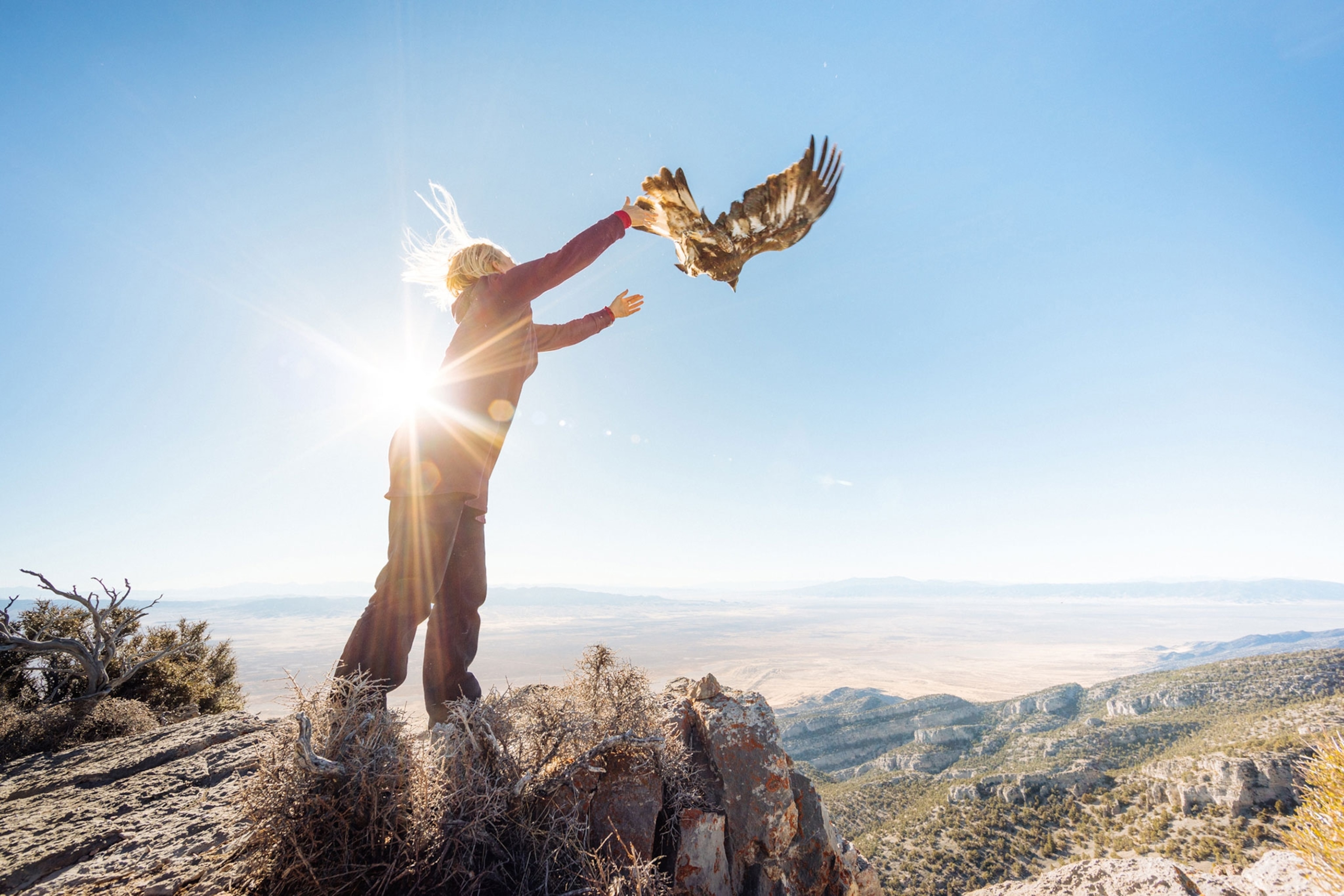
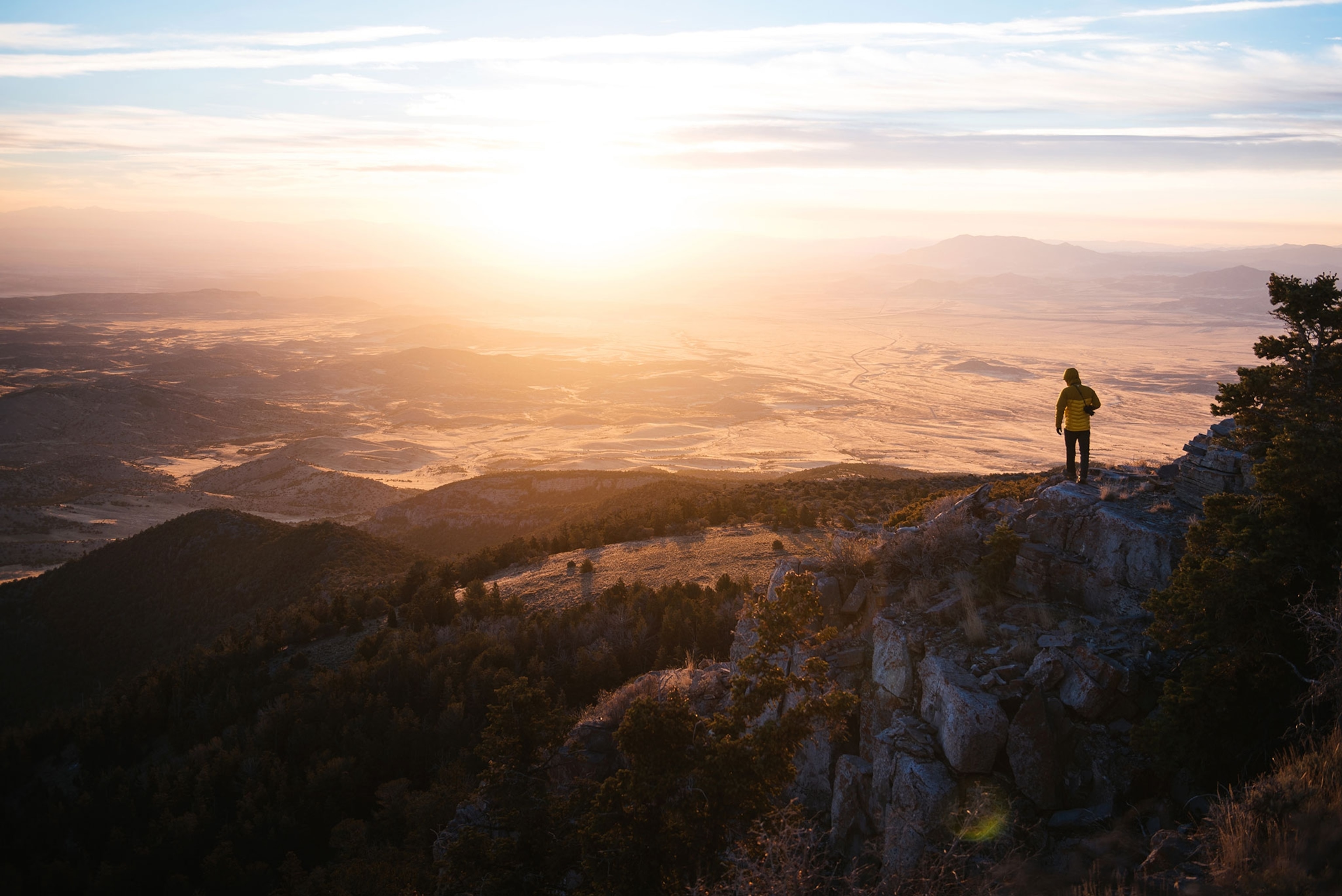
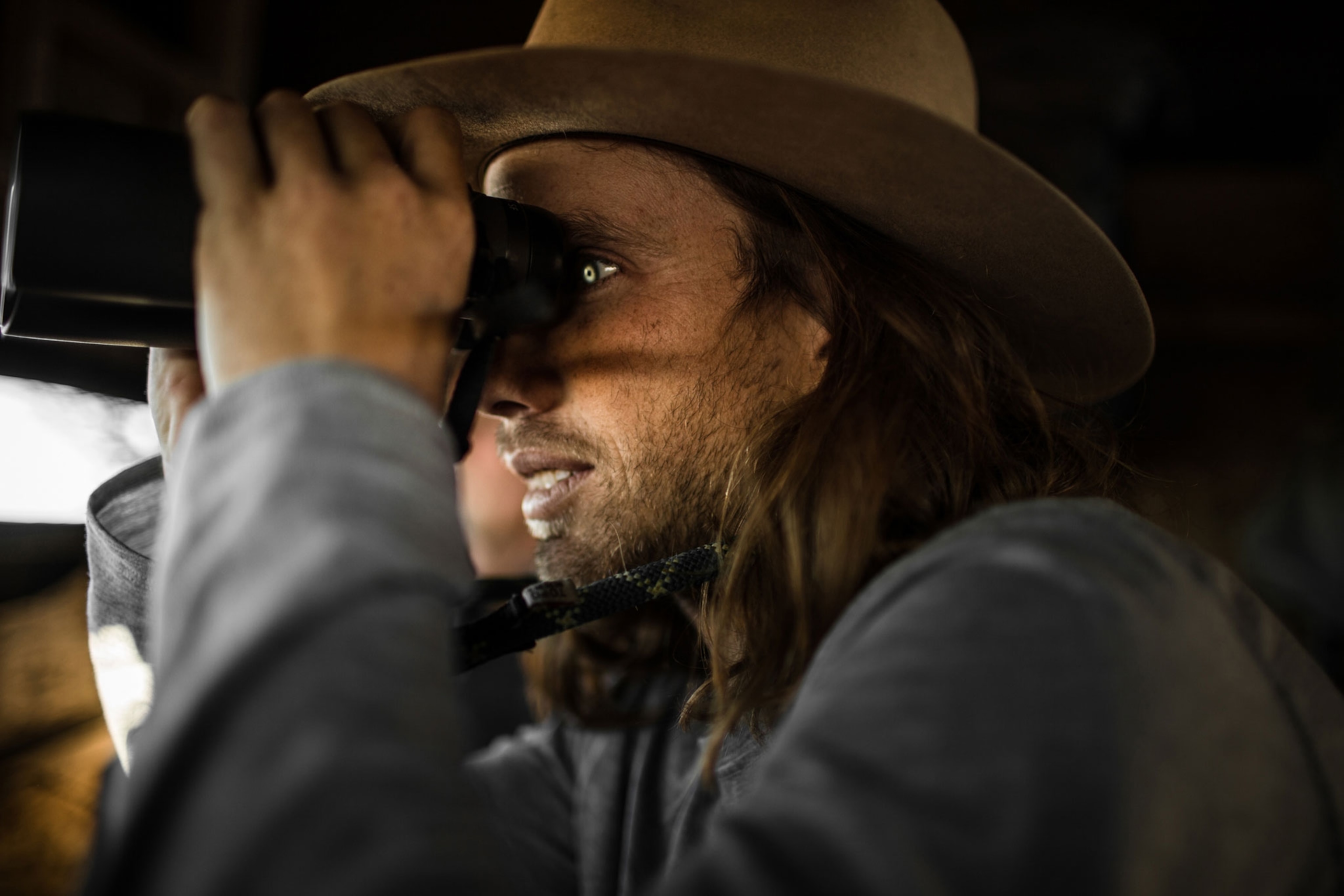
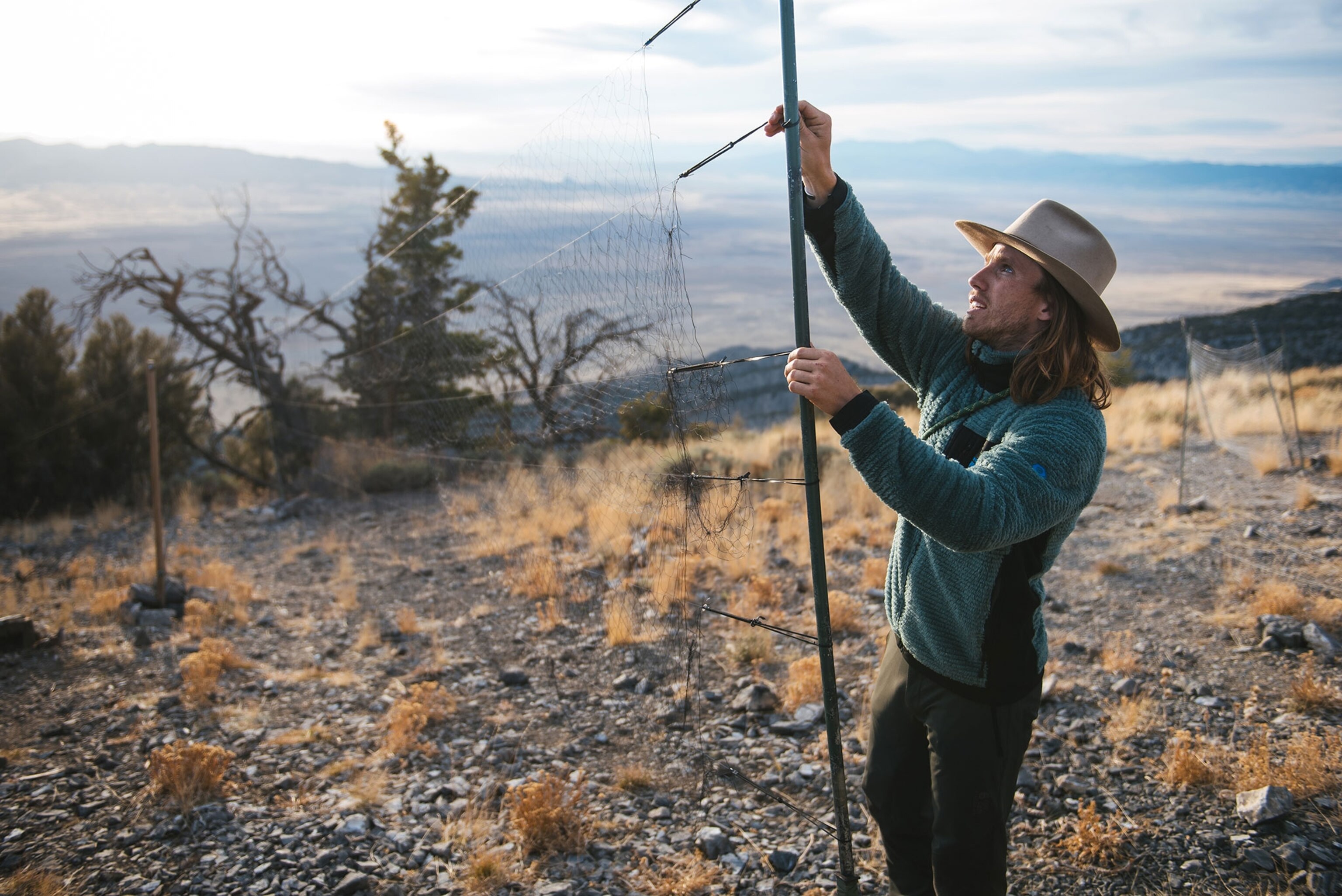

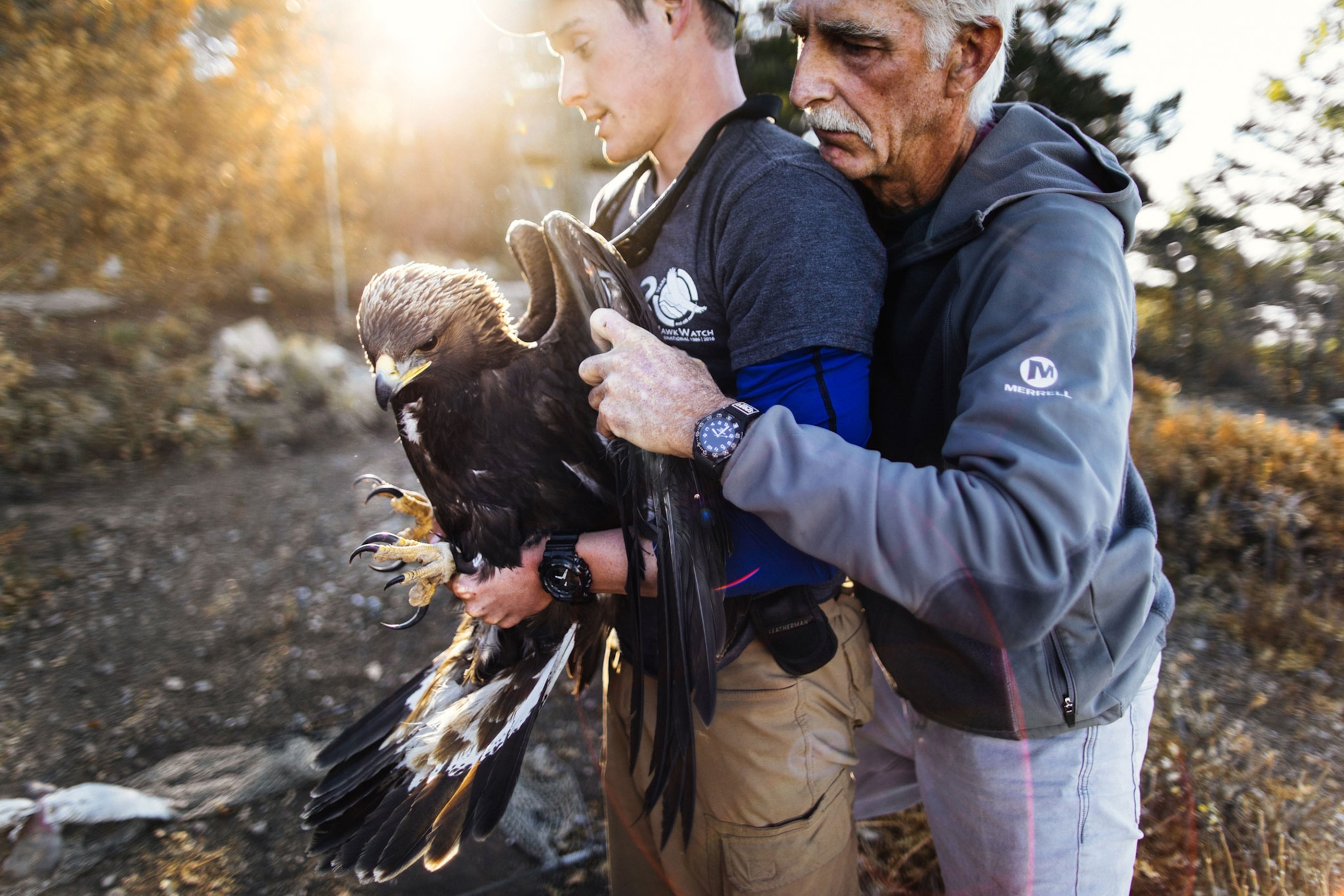




Raptor Road Trip: Tracking Birds of Prey Across the American West
Three friends hit the road to follow hawks and golden eagles on their fall migration, and to collect valuable data that will help scientists understand the birds' ancient journeys.
With outstretched talons, a lone golden eagle dropped from the sky at a speed that must have approached 60 miles an hour. It sped towards the rock-spattered ridgeline beyond our vision. Before any of us could blink, there it was, struggling in the net that surrounded a dead pigeon left as bait. Not 10 feet from where we waited breathlessly behind an army-green blind, the eagle—symbol of wild nature and our national character—was captured, temporarily, to help scientists understand its migratory path.
By the time we —photographers Max Lowe and Forest Woodward, and I, an ecologist fresh from the halls of UC Berkeley—hiked up to the brow of the Goshute Mountains, the raptor migration and research season was nearly over. Golden eagle season, however, was in full swing. We camped nearly 10,000 feet above the Nevada desert with a group of volunteers and field scientists from HawkWatch International, a raptor research and conservation group that operates seven mountaintop banding sites across the northwestern United States. For 70 days a year, HawkWatch International deploys teams of field biologists to key migration paths linking northern forests to the plains and jungles of Central and South America. Wind-chapped field biologists sit under the desert sun with binoculars fixed on the skies. The scientists and volunteers capture, band, and track birds of prey so researchers can collect data over many years that reveal the ecological health of the hemispheres.
We aimed to tell the birds’ story as they embarked on this ancient migration route from the boreal forests of Alaska and Canada to the southern hemisphere, spanning two continents and thousands of miles.
While it takes a village to raise a child, it takes an entire hemisphere to raise a raptor. A landscape devoid of raptors is without ecological integrity, the barometer of our collective wellbeing. High atop these remote ridgelines above the Great Basin, a region of unforgiving deserts, mountain ranges and sagebrush steppes, is the frontline of raptor conservation.
The field biologist loosened his grip on the banded golden eagle. She flapped her enormous wings and flew upward, returning to the jet stream high above, carrying her south and into one of the largest annual migrations in the world. We would shadow her and other raptors south and take a snapshot of the world they inhabit, demonstrating the importance in protecting these symbols of wilderness in a rapidly developing world.
Our first day atop the western edge of the Goshutes graced us with a view of miles of unencumbered sky peppered with migrating raptors. We aimed to observe, document, capture, band, and release every one that we could identify and lure toward us. Embedded in the blind built atop a spit of land in clear view of the migration overhead, we scanned the immediate vicinity for the sign of commitment from a dive-bombing raptor diverted from the migration by the bait—what it thought would be an easy meal of rock dove or starling. During our weeklong expedition we would lock eyes with more golden eagles and red-tailed, sharp-shinned, and Cooper’s hawks enticed by the bait birds.
After two days, we packed our bags and made the trek back to our truck. We, like the raptors, were on a tight schedule and needed to head south to reach HawkWatch International’s site in New Mexico’s Manzano Mountains before it closed its operations for the season. We felt inspired by what we had seen: beautiful birds that we banded and released and a community of dedicated, free-spirited stewards committed to interpreting the barometer of our hemisphere’s health.
It takes a village to raise a child, but it takes an entire hemisphere to raise a raptor.Charles Post
Over a few rounds of yerba mate we spread out a map of North America with dirt-crusted fingers, looking for waypoints that would shadow the migrating birds overhead. We set a course that would guide us from the sagebrush sea of Nevada to the foothills of the Wasatch Mountains, through Moab to southern Colorado, and eventually into central New Mexico. Along the way we would camp, fish, hike, tromp, and trek across the same landscapes in which our elusive golden eagles would roost, hunt, and navigate. We fired up the truck’s engine and Nevada’s Goshute Mountains faded into the rearview mirror.
We camped beneath ancient yellow pines, fished remote river canyons soaked in yellow cottonwood leaves, and barreled down dusty back roads as raptors perched atop windmills, telephone poles, and fence posts. By mile one thousand, our eyes were trained for the birds’ conspicuous silhouettes. We saw them everywhere we looked. It was a sign that wild things still thrived in this landscape, conservation was working, and stewardship had spread across our hemisphere to preserve wilderness for future generations. The widely used pesticide DDT had decimated the survival rates of many bird species, including apex predators like eagles and hawks, in the mid-20th century. Inspired by Rachel Carson’s book Silent Spring, a movement against deadly pesticides grew. In 1972, DDT was outlawed and raptor populations began to recover. The stately hawks we glimpsed on our way to New Mexico were evidence of that shift toward conservation.
The last leg of our own migration cast us into the heart of the Manzano Mountains, a lone and stark range situated 60 miles south of Albuquerque. We made our way through a fire-scarred forest singed by a relentless flame that spared no more than a single tree per slope. As we climbed the meandering two-track we were greeted with an unbroken view that ran north into a building rainstorm streaking across the plains below, dappled with afternoon light. Just as we had been at the Goshute Mountains, we found ourselves welcomed with warm food and cold beers by a tightly knit group of seasoned field biologists with three months’ worth of sun, dirt, and wind smeared across their faces. Around a crackling fire we laughed, told stories, and basked in the appreciation of the wild threads of life.
Before dawn broke the veil of October starlight, the smell of camp coffee and bacon filled the saddle where our hilltop campsite was tucked neatly away from the scouring wind. The sound of cold boots on hard earth rang from the trails connecting two banding stations and an observation deck, where researchers counted every single raptor that poured in from the north. An afternoon squall was pierced by warm rays of light. By 4 p.m. we realized our hope of capturing, banding, and tracking golden eagles from Nevada to New Mexico was fading with each fleeting photon. The banding station closed at 5 p.m. so captured-and-released raptors wouldn’t have to find a roost in the dark.
Forest, Max, and two field biologists were glued to the slit of sky visible through the blind, but their weathered faces showed traces of defeat. We crept out of the south blind for the last time, and made our way towards camp.
We stopped at the observation deck to take one last northerly glance into the migration route. In that moment, two specks seemed to appear from nothing in the sky above. As they neared, we realized they were a pair of golden eagles. As they emerged from the hazy distance, one of the two had already committed to a wayward ribbon of wind, and passed us without more than a glance. But the second, more distant golden eagle had his head turned with eyes fixed on our northern blind. He tucked its wings into a steep dive and disappeared behind the low pines obscuring the north blind. With racing hearts, we ran down-trail, frantically prepping our cameras and discussing how to best document this moment that clinched our journey in so many ways.
As we made the last switchback through the grove of head-high scrub oaks, we saw something few ever do: a golden eagle in the hands of a biologist, 9,500 feet above the New Mexican desert floor. It was a moment that stopped us in our tracks, spiked our heart rates and reminded us we had an epic story to tell.
Our journey ended with the first whisk of broad wings. The golden eagle took flight and floated skyward. We had joined the migration and followed golden eagles for thousands of miles—a fraction of their entire route—and just long enough to peek into their remarkable journey. We got to know and admire the biologists and passionate volunteers who briefly intercept a handful of them along the way, gathering information that will help generations of raptors to come. We drove, hiked, fished, and camped in the unforgiving landscapes that these wayward fliers have relied on for millennia.
And perhaps most importantly, we experienced what stewardship and conservation can accomplish. Fifty years ago, golden eagles and their raptor allies hung on the edge of extinction. A collective decision was made to ensure that raptors must continue to flood autumn skies. And while the efforts of a few dozen biologists may seem insignificant, it’s the cumulative effort over decades that counts, and it shapes the future of our planet’s wild places and creatures.
You May Also Like
Go Further
Animals
- California brown pelicans are starving to death—despite plenty to eatCalifornia brown pelicans are starving to death—despite plenty to eat
- The world's largest fish are vanishing without a traceThe world's largest fish are vanishing without a trace
- We finally know how cockroaches conquered the worldWe finally know how cockroaches conquered the world
- Why America's 4,000 native bees need their day in the sunWhy America's 4,000 native bees need their day in the sun
- Crowdsourcing an anti-poaching movement in South Africa
- Paid Content
Crowdsourcing an anti-poaching movement in South Africa
Environment
- 2024 hurricane season forecasted to be record-breaking year2024 hurricane season forecasted to be record-breaking year
- Connecting a new generation with South Africa’s iconic species
- Paid Content
Connecting a new generation with South Africa’s iconic species - These images will help you see coral reefs in a whole new wayThese images will help you see coral reefs in a whole new way
- What rising temps in the Gulf of Maine mean for wildlifeWhat rising temps in the Gulf of Maine mean for wildlife
- He’s called ‘omacha,’ a dolphin that transforms into a man. Why?He’s called ‘omacha,’ a dolphin that transforms into a man. Why?
History & Culture
- I wrote this article with a 18th century quill. I recommend it.I wrote this article with a 18th century quill. I recommend it.
- Why this Bronze Age village became known as ‘Britain’s Pompeii’Why this Bronze Age village became known as ‘Britain’s Pompeii’
- These modern soldiers put Bronze Age armor to the testThese modern soldiers put Bronze Age armor to the test
- Should couples normalize sleeping in separate beds?Should couples normalize sleeping in separate beds?
- They were rock stars of paleontology—and their feud was legendaryThey were rock stars of paleontology—and their feud was legendary
Science
- Epidurals may do more than relieve pain—they could save livesEpidurals may do more than relieve pain—they could save lives
- Why the world's oldest sport is still one of the best exercisesWhy the world's oldest sport is still one of the best exercises
- What if aliens exist—but they're just hiding from us?What if aliens exist—but they're just hiding from us?
Travel
- This road trip journeys through Albania's wild, blue heartThis road trip journeys through Albania's wild, blue heart
- This less crowded ancient temple in Laos rivals Angkor WatThis less crowded ancient temple in Laos rivals Angkor Wat
- Visit Rotterdam as it transforms itself into a floating cityVisit Rotterdam as it transforms itself into a floating city
- How to get off the beaten track in Northern LanzaroteHow to get off the beaten track in Northern Lanzarote






